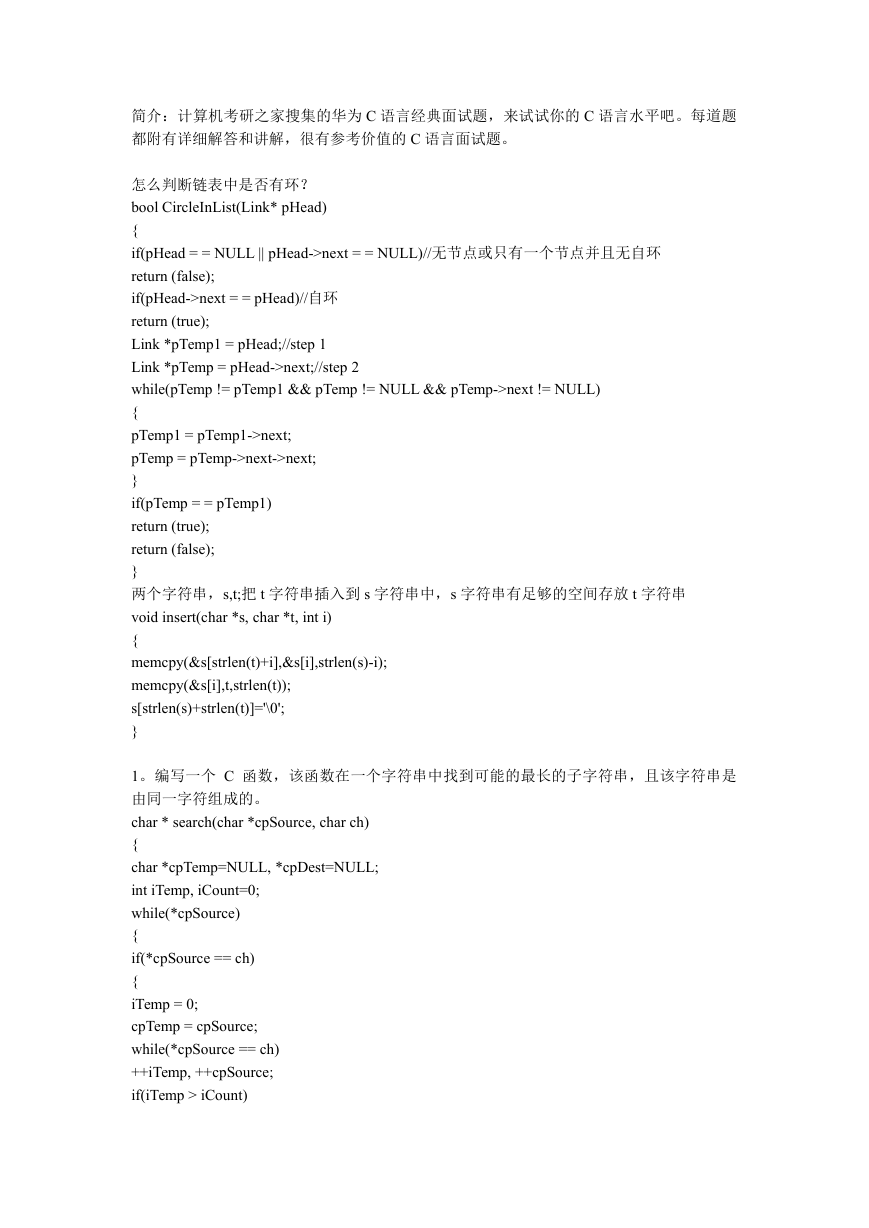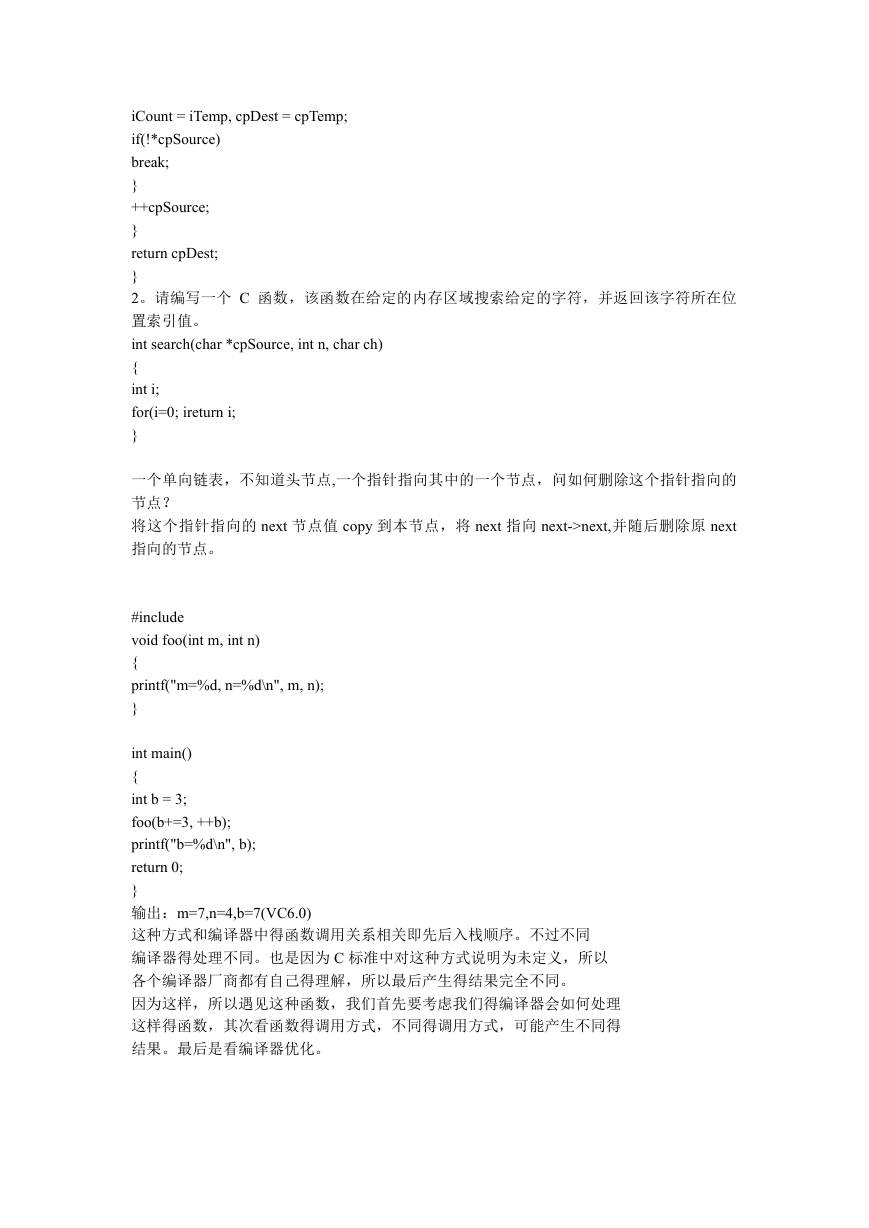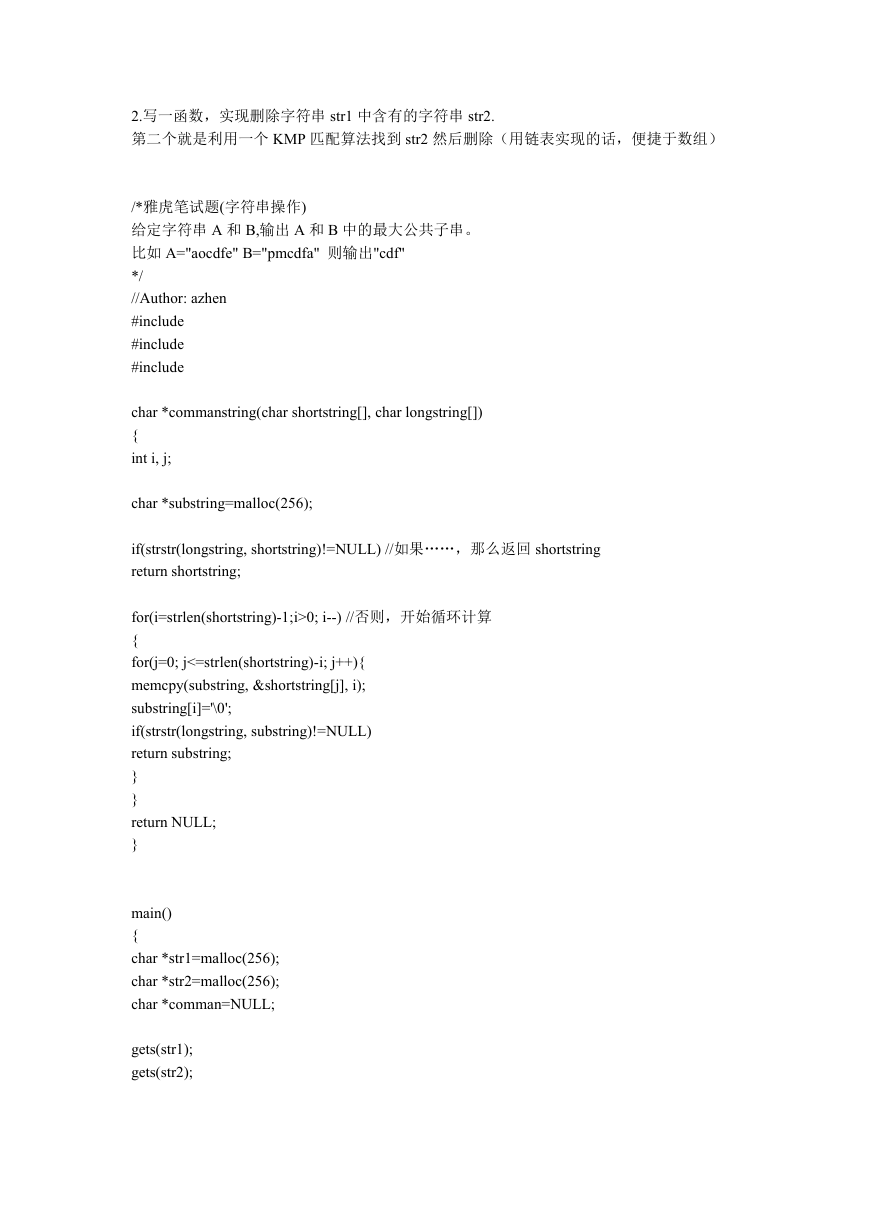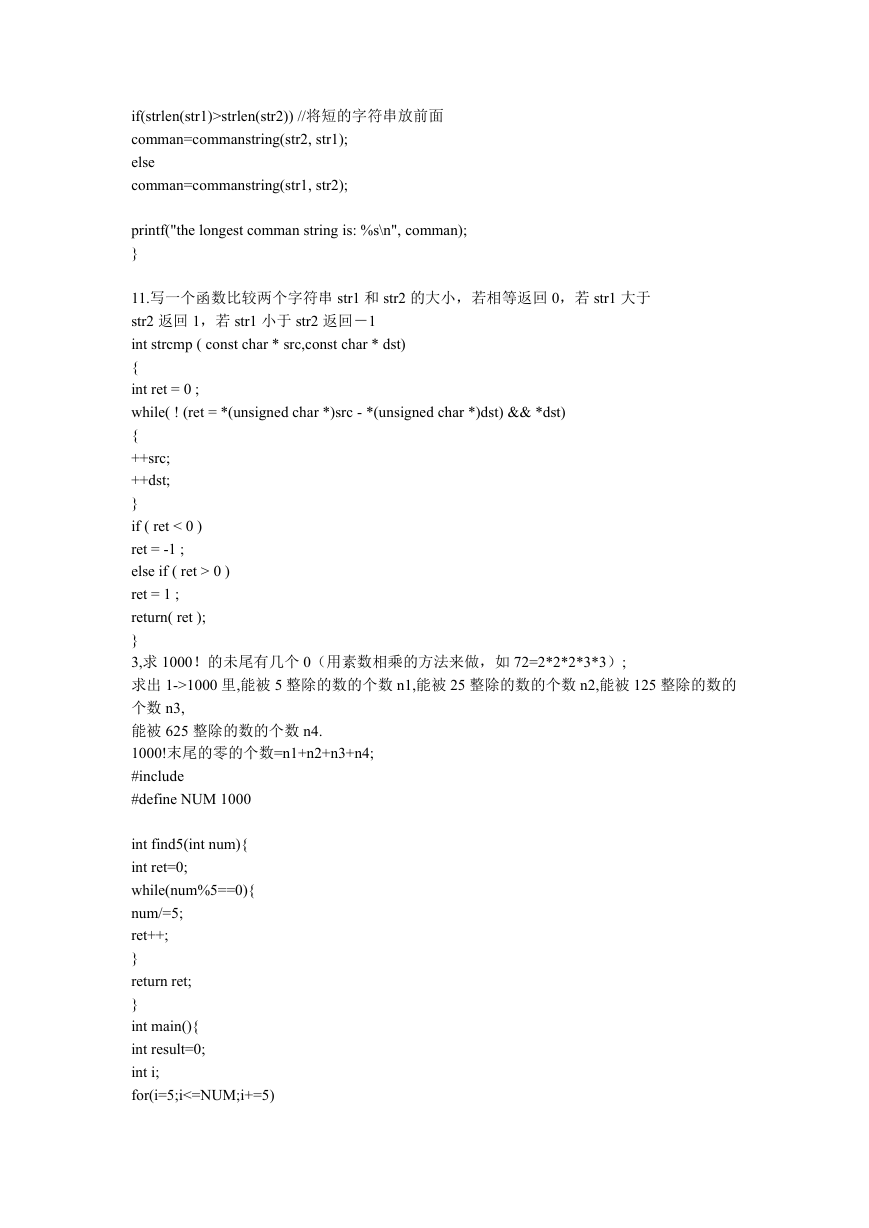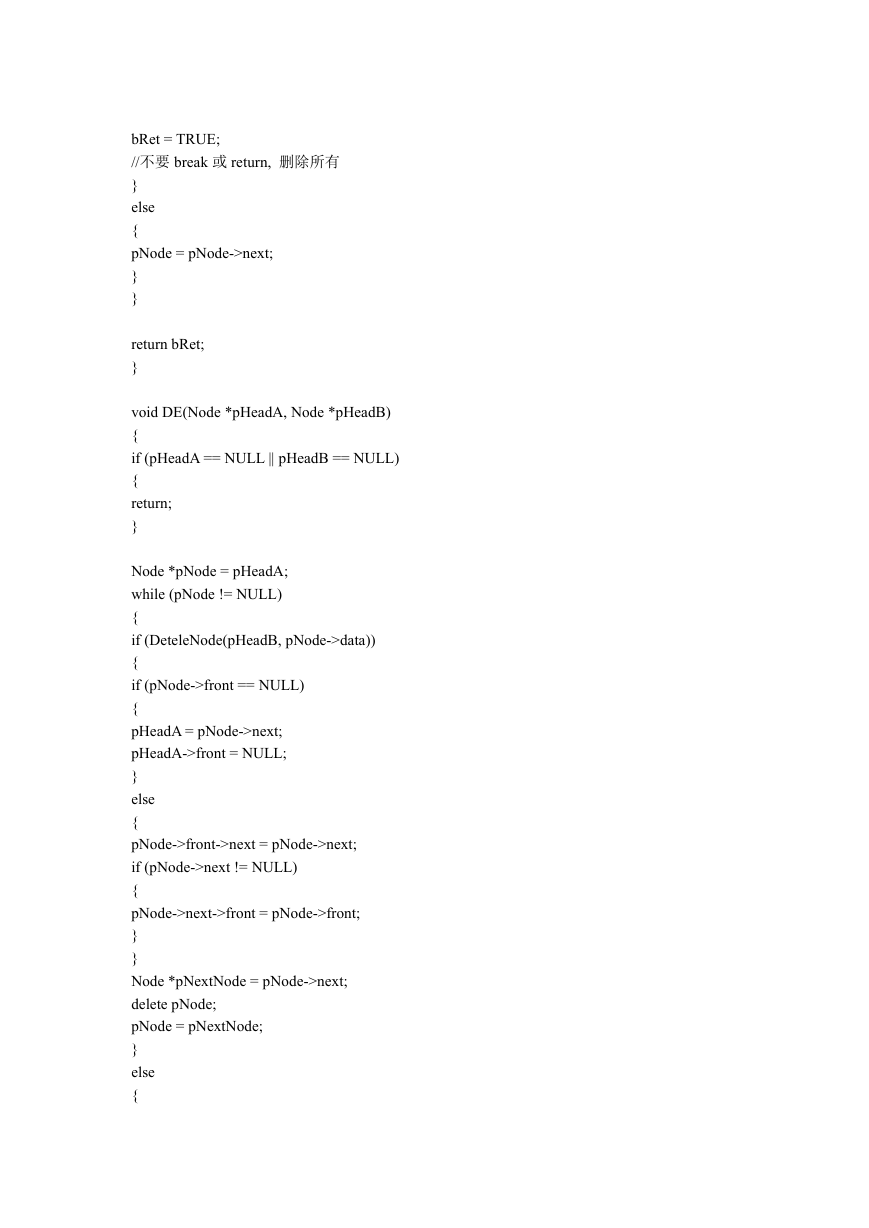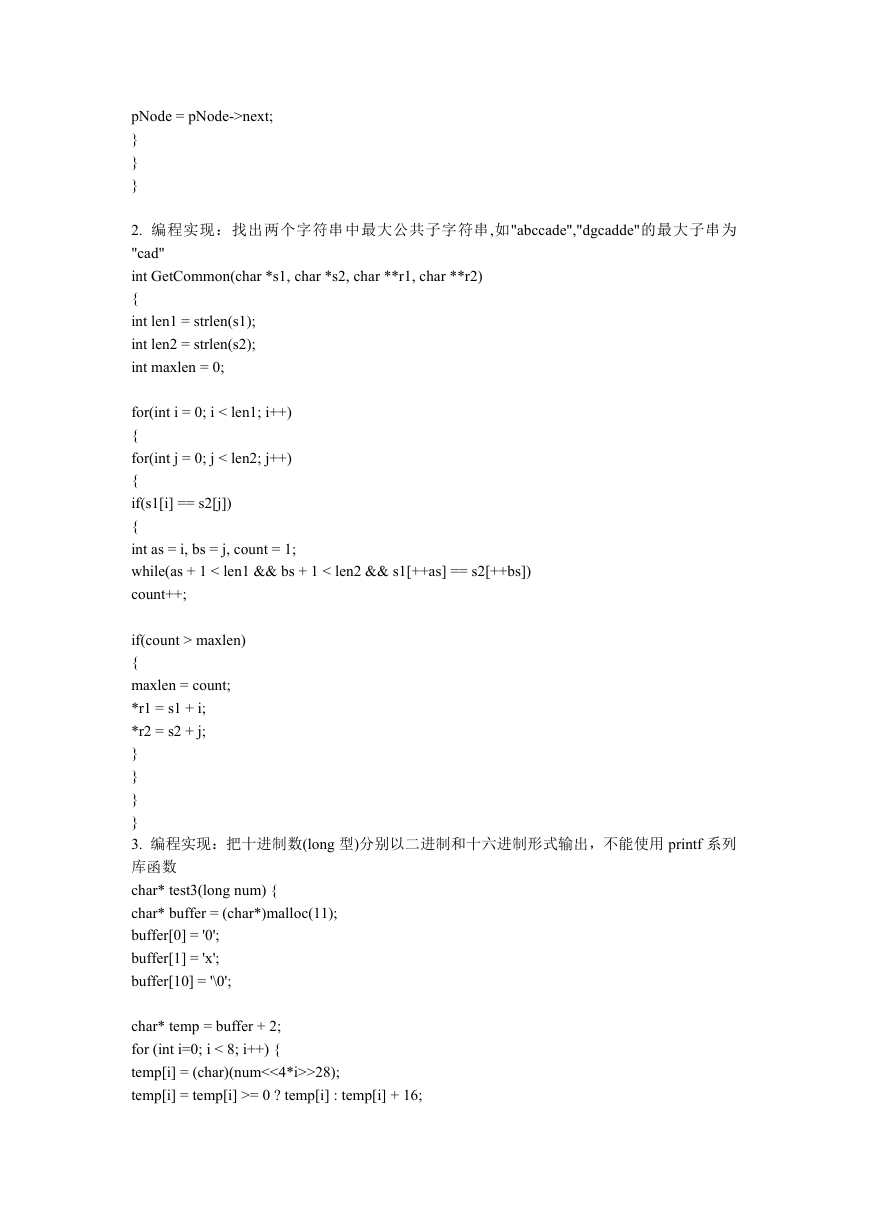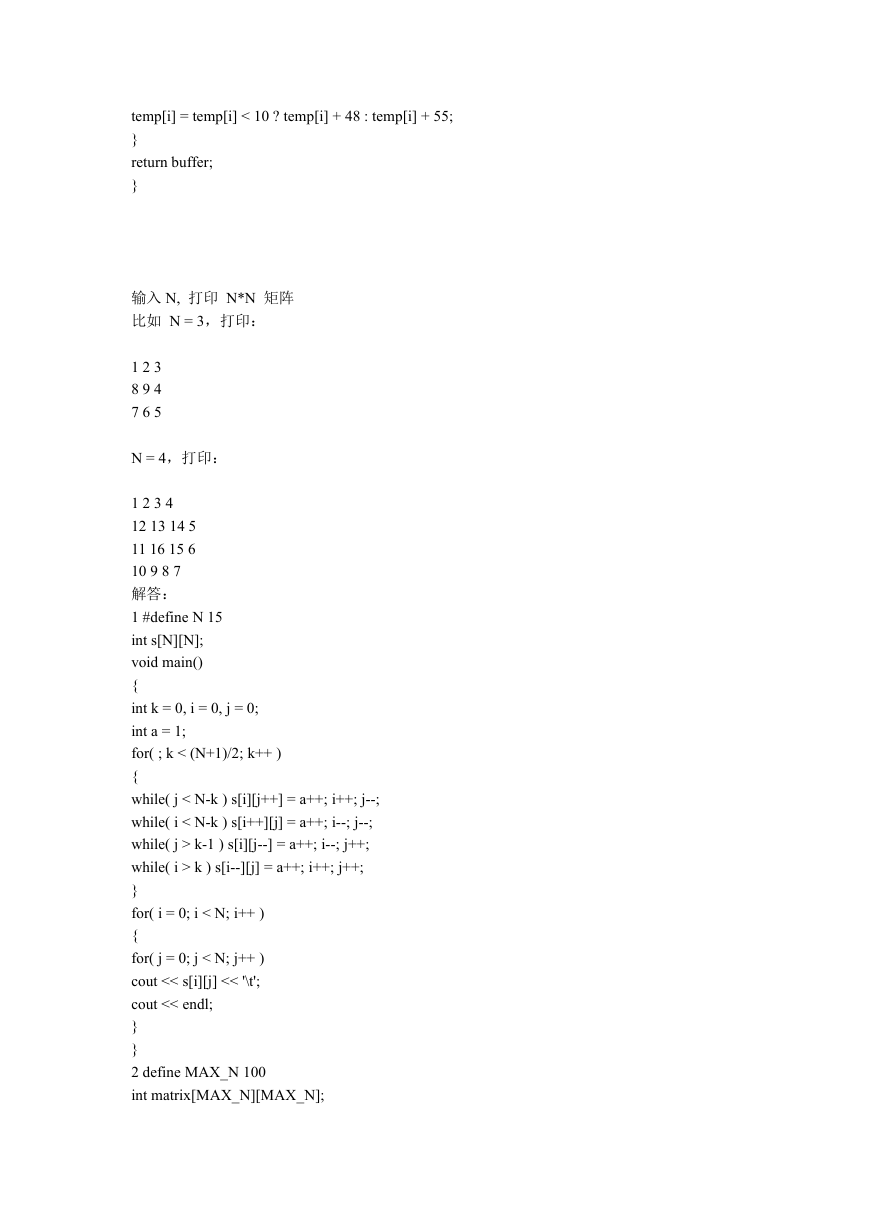简介:计算机考研之家搜集的华为 C 语言经典面试题,来试试你的 C 语言水平吧。每道题
都附有详细解答和讲解,很有参考价值的 C 语言面试题。
怎么判断链表中是否有环?
bool CircleInList(Link* pHead)
{
if(pHead = = NULL || pHead->next = = NULL)//无节点或只有一个节点并且无自环
return (false);
if(pHead->next = = pHead)//自环
return (true);
Link *pTemp1 = pHead;//step 1
Link *pTemp = pHead->next;//step 2
while(pTemp != pTemp1 && pTemp != NULL && pTemp->next != NULL)
{
pTemp1 = pTemp1->next;
pTemp = pTemp->next->next;
}
if(pTemp = = pTemp1)
return (true);
return (false);
}
两个字符串,s,t;把 t 字符串插入到 s 字符串中,s 字符串有足够的空间存放 t 字符串
void insert(char *s, char *t, int i)
{
memcpy(&s[strlen(t)+i],&s[i],strlen(s)-i);
memcpy(&s[i],t,strlen(t));
s[strlen(s)+strlen(t)]='\0';
}
1。编写一个 C 函数,该函数在一个字符串中找到可能的最长的子字符串,且该字符串是
由同一字符组成的。
char * search(char *cpSource, char ch)
{
char *cpTemp=NULL, *cpDest=NULL;
int iTemp, iCount=0;
while(*cpSource)
{
if(*cpSource == ch)
{
iTemp = 0;
cpTemp = cpSource;
while(*cpSource == ch)
++iTemp, ++cpSource;
if(iTemp > iCount)
�
iCount = iTemp, cpDest = cpTemp;
if(!*cpSource)
break;
}
++cpSource;
}
return cpDest;
}
2。请编写一个 C 函数,该函数在给定的内存区域搜索给定的字符,并返回该字符所在位
置索引值。
int search(char *cpSource, int n, char ch)
{
int i;
for(i=0; ireturn i;
}
一个单向链表,不知道头节点,一个指针指向其中的一个节点,问如何删除这个指针指向的
节点?
将这个指针指向的 next 节点值 copy 到本节点,将 next 指向 next->next,并随后删除原 next
指向的节点。
#include
void foo(int m, int n)
{
printf("m=%d, n=%d\n", m, n);
}
int main()
{
int b = 3;
foo(b+=3, ++b);
printf("b=%d\n", b);
return 0;
}
输出:m=7,n=4,b=7(VC6.0)
这种方式和编译器中得函数调用关系相关即先后入栈顺序。不过不同
编译器得处理不同。也是因为 C 标准中对这种方式说明为未定义,所以
各个编译器厂商都有自己得理解,所以最后产生得结果完全不同。
因为这样,所以遇见这种函数,我们首先要考虑我们得编译器会如何处理
这样得函数,其次看函数得调用方式,不同得调用方式,可能产生不同得
结果。最后是看编译器优化。
�
2.写一函数,实现删除字符串 str1 中含有的字符串 str2.
第二个就是利用一个 KMP 匹配算法找到 str2 然后删除(用链表实现的话,便捷于数组)
/*雅虎笔试题(字符串操作)
给定字符串 A 和 B,输出 A 和 B 中的最大公共子串。
比如 A="aocdfe" B="pmcdfa" 则输出"cdf"
*/
//Author: azhen
#include
#include
#include
char *commanstring(char shortstring[], char longstring[])
{
int i, j;
char *substring=malloc(256);
if(strstr(longstring, shortstring)!=NULL) //如果……,那么返回 shortstring
return shortstring;
for(i=strlen(shortstring)-1;i>0; i--) //否则,开始循环计算
{
for(j=0; j<=strlen(shortstring)-i; j++){
memcpy(substring, &shortstring[j], i);
substring[i]='\0';
if(strstr(longstring, substring)!=NULL)
return substring;
}
}
return NULL;
}
main()
{
char *str1=malloc(256);
char *str2=malloc(256);
char *comman=NULL;
gets(str1);
gets(str2);
�
if(strlen(str1)>strlen(str2)) //将短的字符串放前面
comman=commanstring(str2, str1);
else
comman=commanstring(str1, str2);
printf("the longest comman string is: %s\n", comman);
}
11.写一个函数比较两个字符串 str1 和 str2 的大小,若相等返回 0,若 str1 大于
str2 返回 1,若 str1 小于 str2 返回-1
int strcmp ( const char * src,const char * dst)
{
int ret = 0 ;
while( ! (ret = *(unsigned char *)src - *(unsigned char *)dst) && *dst)
{
++src;
++dst;
}
if ( ret < 0 )
ret = -1 ;
else if ( ret > 0 )
ret = 1 ;
return( ret );
}
3,求 1000!的未尾有几个 0(用素数相乘的方法来做,如 72=2*2*2*3*3);
求出 1->1000 里,能被 5 整除的数的个数 n1,能被 25 整除的数的个数 n2,能被 125 整除的数的
个数 n3,
能被 625 整除的数的个数 n4.
1000!末尾的零的个数=n1+n2+n3+n4;
#include
#define NUM 1000
int find5(int num){
int ret=0;
while(num%5==0){
num/=5;
ret++;
}
return ret;
}
int main(){
int result=0;
int i;
for(i=5;i<=NUM;i+=5)
�
{
result+=find5(i);
}
printf(" the total zero number is %d\n",result);
return 0;
}
1. 有双向循环链表结点定义为:
struct node
{ int data;
struct node *front,*next;
};
有两个双向循环链表 A,B,知道其头指针为:pHeadA,pHeadB,请写一函数将两链表中 data
值相同的结点删除
BOOL DeteleNode(Node *pHeader, DataType Value)
{
if (pHeader == NULL) return;
BOOL bRet = FALSE;
Node *pNode = pHead;
while (pNode != NULL)
{
if (pNode->data == Value)
{
if (pNode->front == NULL)
{
pHeader = pNode->next;
pHeader->front = NULL;
}
else
{
if (pNode->next != NULL)
{
pNode->next->front = pNode->front;
}
pNode->front->next = pNode->next;
}
Node *pNextNode = pNode->next;
delete pNode;
pNode = pNextNode;
�
bRet = TRUE;
//不要 break 或 return, 删除所有
}
else
{
pNode = pNode->next;
}
}
return bRet;
}
void DE(Node *pHeadA, Node *pHeadB)
{
if (pHeadA == NULL || pHeadB == NULL)
{
return;
}
Node *pNode = pHeadA;
while (pNode != NULL)
{
if (DeteleNode(pHeadB, pNode->data))
{
if (pNode->front == NULL)
{
pHeadA = pNode->next;
pHeadA->front = NULL;
}
else
{
pNode->front->next = pNode->next;
if (pNode->next != NULL)
{
pNode->next->front = pNode->front;
}
}
Node *pNextNode = pNode->next;
delete pNode;
pNode = pNextNode;
}
else
{
�
pNode = pNode->next;
}
}
}
2. 编程实现:找出两个字符串中最大公共子字符串,如"abccade","dgcadde"的最大子串为
"cad"
int GetCommon(char *s1, char *s2, char **r1, char **r2)
{
int len1 = strlen(s1);
int len2 = strlen(s2);
int maxlen = 0;
for(int i = 0; i < len1; i++)
{
for(int j = 0; j < len2; j++)
{
if(s1[i] == s2[j])
{
int as = i, bs = j, count = 1;
while(as + 1 < len1 && bs + 1 < len2 && s1[++as] == s2[++bs])
count++;
if(count > maxlen)
{
maxlen = count;
*r1 = s1 + i;
*r2 = s2 + j;
}
}
}
}
3. 编程实现:把十进制数(long 型)分别以二进制和十六进制形式输出,不能使用 printf 系列
库函数
char* test3(long num) {
char* buffer = (char*)malloc(11);
buffer[0] = '0';
buffer[1] = 'x';
buffer[10] = '\0';
char* temp = buffer + 2;
for (int i=0; i < 8; i++) {
temp[i] = (char)(num<<4*i>>28);
temp[i] = temp[i] >= 0 ? temp[i] : temp[i] + 16;
�
temp[i] = temp[i] < 10 ? temp[i] + 48 : temp[i] + 55;
}
return buffer;
}
输入 N, 打印 N*N 矩阵
比如 N = 3,打印:
1 2 3
8 9 4
7 6 5
N = 4,打印:
1 2 3 4
12 13 14 5
11 16 15 6
10 9 8 7
解答:
1 #define N 15
int s[N][N];
void main()
{
int k = 0, i = 0, j = 0;
int a = 1;
for( ; k < (N+1)/2; k++ )
{
while( j < N-k ) s[i][j++] = a++; i++; j--;
while( i < N-k ) s[i++][j] = a++; i--; j--;
while( j > k-1 ) s[i][j--] = a++; i--; j++;
while( i > k ) s[i--][j] = a++; i++; j++;
}
for( i = 0; i < N; i++ )
{
for( j = 0; j < N; j++ )
cout << s[i][j] << '\t';
cout << endl;
}
}
2 define MAX_N 100
int matrix[MAX_N][MAX_N];
�
